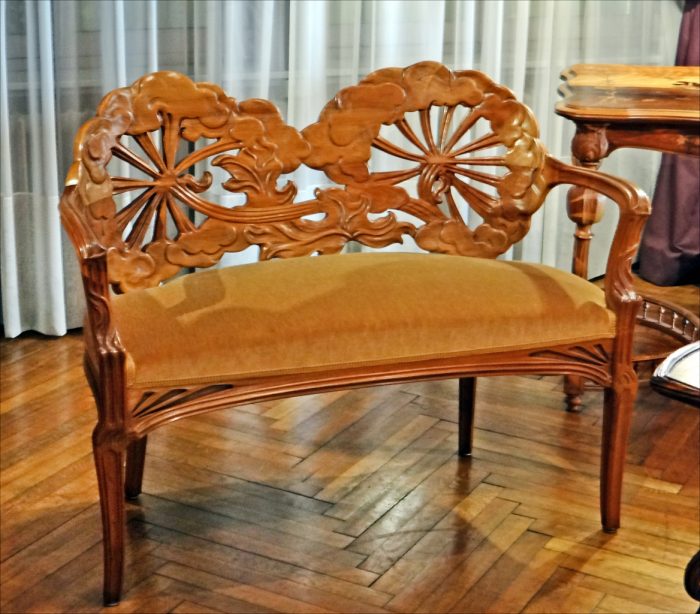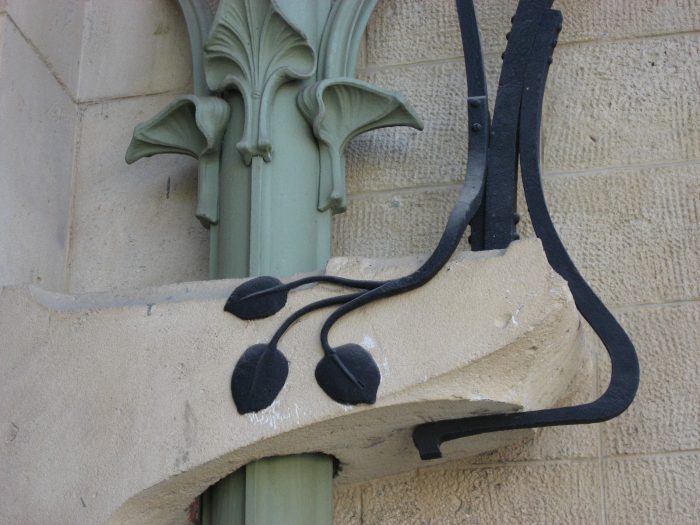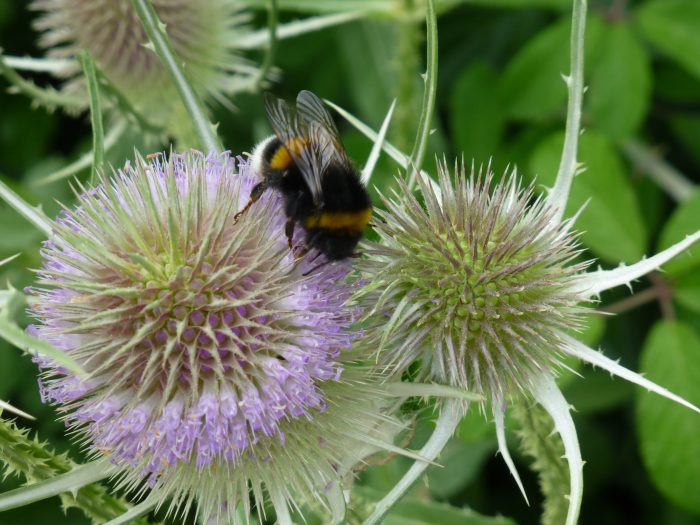Mathilde Linois offers us a brief on the representation of nature in Art Nouveau, as part of the call for articles #Art et Botanique.
Inspired by the Arts and Crafts movement brought about by William Morris in England, Art Nouveau developed in France in the late 19th century. This artistic movement is characterized in particular by its multiple references to nature. Leaf arabesques, intertwining stems and flamboyant flowers are at the heart of this unique and exciting movement.
What is at stake in this total art? What are your favorite plant motifs? Read this article to learn more about the representation of nature in Art Nouveau.
During the 19th century, the industrial revolution marked an important turning point in the way we consume. The production of objects intensifies thanks to mass production, made possible by machines. Department stores stock large quantities of items and accessories. Therefore, the interiors tend to look alike.
To counter this phenomenon, some artists unite around a common project: that of bringing craftsmanship back to the center of human activity. Thus they free themselves from the traditional boundary between craftsmanship and art. Architecture, painting, cabinet making, artistic ironwork, stained glass art, all know-how is used. In the minds of these artists, art and beauty must surround human beings to beautify their daily lives and feed their aspirations.
Quickly, nature becomes the favorite source of inspiration, due to several factors.
On the one hand, the nineteenth century is the century par excellence for the study of the living. Scientists are passionate about all biological and natural systems. In this context, the botanical tables multiply and inspire the artists.
On the other hand, people are passionate about the Orient and its representations, which contributes to the emergence of two currents: Orientalism and Japonism. The latter will be a big hit with the Art Nouveau artists. In fact, the public marvels at the Japanese prints, covered with exotic plants and distant landscapes.
In France, Art Nouveau develops especially in Nancy where public and private parks are numerous. Horticulturists and botanists compete in effort and creativity to offer exotic or hybrid varieties. Furthermore, these plant demonstrations are often found next to the craftsmen, as is the case in the gardens of Victor Lemoine and the workshops of Émile Gallé, founder of the Ecole de Nancy. The latter notably became secretary of the Central Horticultural Society created in 1877.
Thus, nature will inspire the greatest artists of the time: the architect Louis Majorelle, the master glassmaker Jacques Gruber or the decorator and illustrator Henri Bergé.
Nancy (Meurthe-et-Moselle) – Nancy School Museum – Central elements of the stained glass window of the “La Salle” veranda, “Dove and peacock” (Jacques Gruber, circa 1904)
One of the features of Art Nouveau is the observation of flora as a whole. The inspirations are different and concern plants, trees, vines, stems, but also flowers.
The ginkgo biloba
Ginkgo biloba is also called maidenhair tree. Originally from China, it was then imported to Korea and Japan, where it became the emblem of the city of Tokyo. In autumn its foliage takes on a golden yellow colour, similar to gold.
One of the peculiarities of Ginkgo is that it is the only survivor of the ginkgoaceae family. Very resistant, it can reach 30 meters in height and live for thousands of years.
Symbols of prosperity, its leaves also recall the shape of fans, very popular accessories in the 19th century.

Ginkgo photo: By user: Ajax — Photo by Ajax, CC BY-SA Wikipedia
umbrella
The umbel is a botanical term for a particular type of inflorescence in which all flower stalks are attached by a single point to the stem. Interestingly, the word “umbrella” comes from the Latin an umbrella, which means parasol and which gave rise to the word “umbrella”. However, in Asian culture, the umbrella is very important and symbolizes sovereignty.
The Art Nouveau artists managed to perceive the beauty of the umbelliferous plants and took back their parasol shape in the creation of various furnishing elements: showcases, chairs, tables.

Bench with Umbrellas: by Jean-Pierre Dalbéra of Paris, France — Bench with Umbrellas (Ecole de Nancy museum), CC BY-SA Wikipedia
the iris
Floral motifs also take pride of place in Art Nouveau. If the orchid, the rose or the poppy are regularly mentioned, the iris has a place of choice in Art Nouveau works.
In ancient times, iris was said to have the ability to lead the souls of the dead to the underworld. We find this plant on Egyptian and Etruscan funerary monuments or in the Greco-Roman world.
Equipped with recognizable petals, its flower has beautiful shades ranging from purple to blue. This variation of tones inspired many artists, including Henri Matisse and Vincent Van Gogh. During the Art Nouveau period, this flower was often represented by glass masters, especially Émile Gallé and the Daum house.

Dam Iris Vase: CC BY-SA, Wikipedia
the moon
Surely you know the Lunar annual with one of its many names: lunar, coin of the pope, medallions of Judas or herbs aux écus.
Well known for its fruits, which look like iridescent white circles, the moonflower also produces pretty little fuchsia or white flowers.
The architect Louis Majorelle chose the moon as the main theme when designing his villa, visible in Nancy. It is thanks to the artistic working of iron that the artist was able to imitate the moon. It runs on the facade, as well as on the stairs of the house.

Facade with moons of Villa Majorelle: By I, Liné1, CC BY-SA Wikipedia
Thistle
The Art Nouveau artists were not only interested in so-called “noble” plants, but were also inspired by plants considered “weeds”.
This is the case of the thistle, very present on the outskirts of Nancy. In the 15th century, the Duke of Lorraine adopted the motto: “Qui s’y rubtte, s’y pique”, in reference to this perennial plant. Resistant and tenacious, the thistle symbolizes longevity and perseverance.
It became popular in Art Nouveau thanks to the famous botanical plate made in watercolor by Henri Bergé.

Chardon, author: Anne Leclef, Pictoflora CC BY-SA
If you want to learn more about the links between art and botany in Art Nouveau, here are three works that influenced the look of the movement:
- Architecture interviewsby Eugène Viollet-le-Duc, 1863;
- Art forms of natureErnst Haeckel, 1834;
- The plant and its ornamental applicationsunder the direction of Eugène Grasset, 1896.
Thanks to this article, you now feel the importance of nature in Art Nouveau works. If this topic interests you, you will surely enjoy learning more about it the living museumwhich preserves old collections of the École de Nancy.


